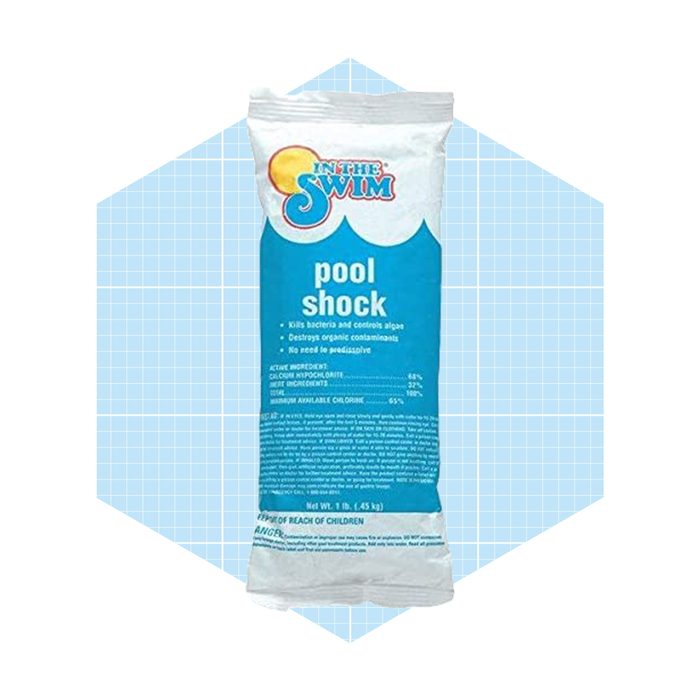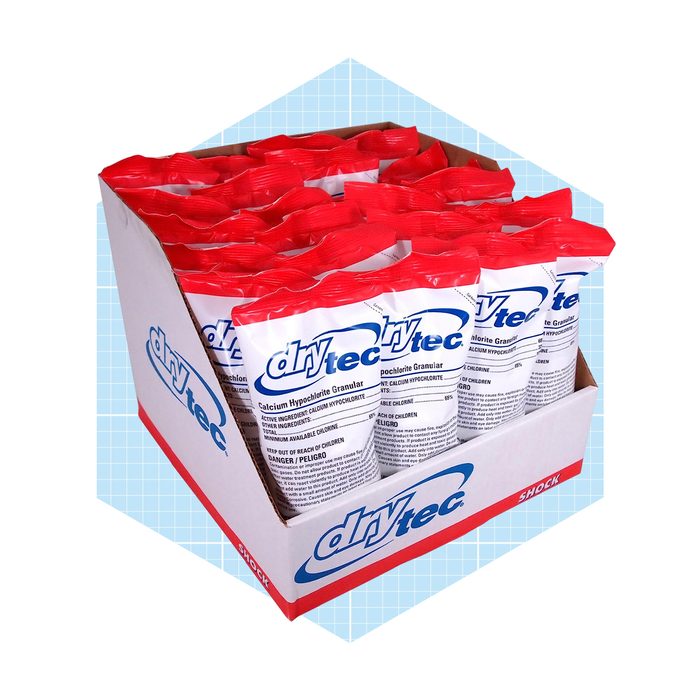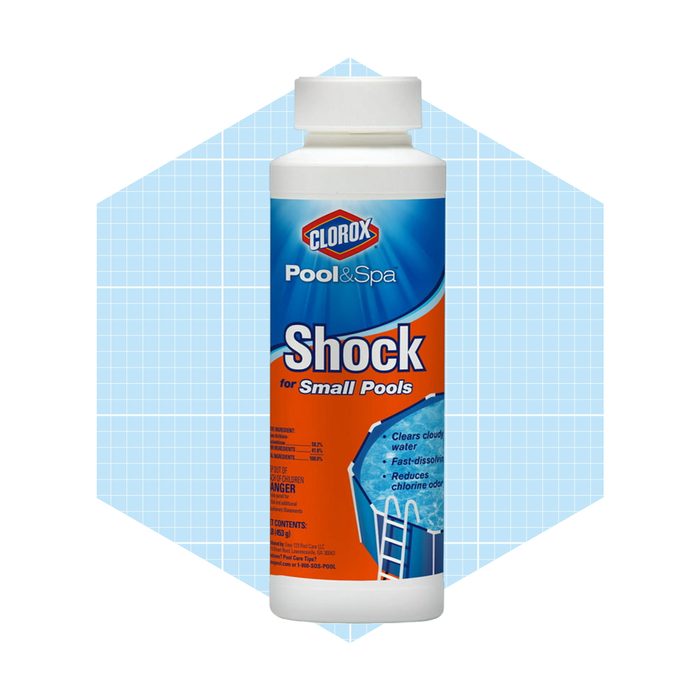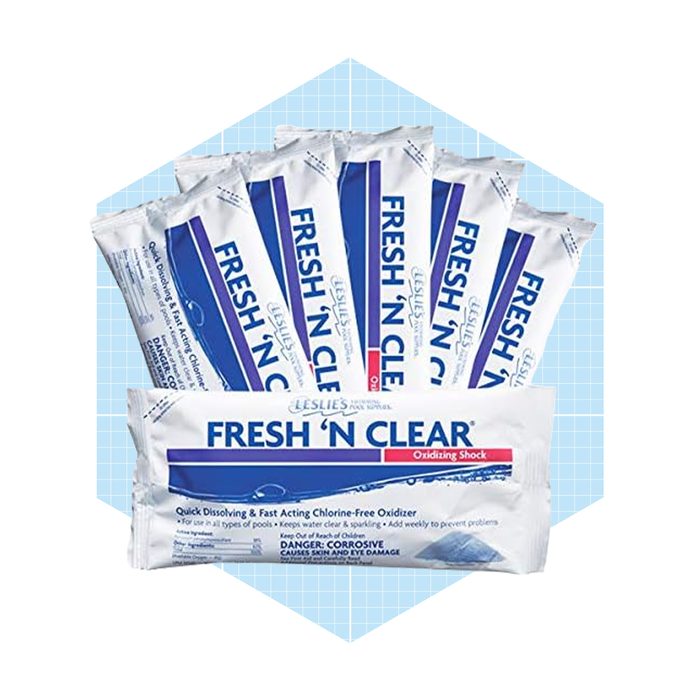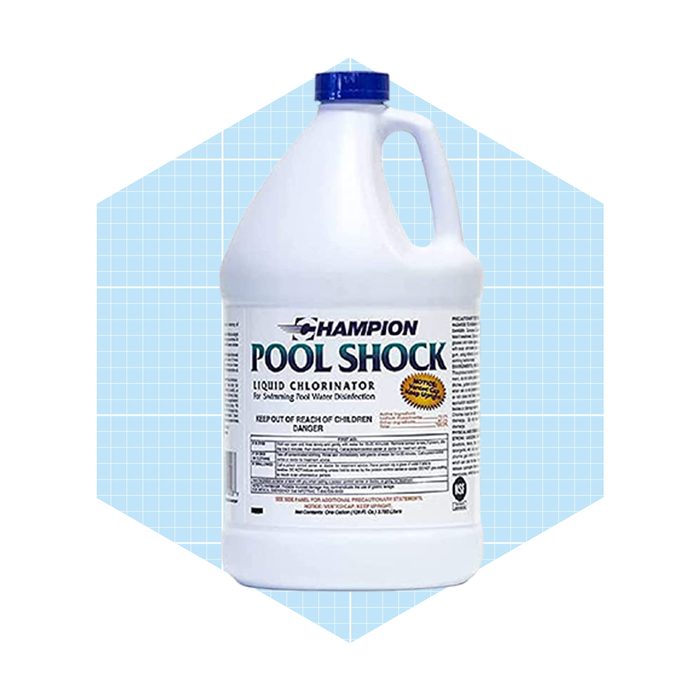via merchant
via merchant
Pros:
-
Strong formula with commercial-grade bleach
-
Pours right into the pool water
-
No granules to dissolve
-
Does not cloud pool
Cons:
-
Liquid chlorine is unstable and will lose potency within 6 months
-
Risk of splashing on skin, eyes or clothing
This strong formula uses 12.5% sodium hypochlorite, or liquid bleach, as its active shock ingredient. Since it’s in liquid form, you add it directly to your pool without waiting for granules to dissolve.
Champion Liquid Pool Shock is a quick, powerful fix for algae and bacteria and is safe for vinyl liners and saltwater pools. It also has other uses, such as a cleaning solution (when diluted) for pressure washing. Verified Amazon purchaser Barry Harrell says it’s the best treatment for “when the pool gets out of hand” and loves that “the price is right and it works really well.”
What to Consider When Buying Pool Shock
Shocking a pool is a standard part of pool ownership and maintenance. When choosing a pool shock product, pay attention to the product’s compatibility with your type of pool. Vinyl liners, in particular, are vulnerable to damage from shock granules that may accumulate on the bottom of the pool.
Every pool’s chemical balance is different, and it may take a few test runs with different formulas to determine the best pool shock for your pool. While pool maintenance is a perfectly reasonably DIY task, we recommend that you periodically take a sample of your pool water to your local pool supply store, especially if you’re having difficulty getting pH and total alkalinity numbers where they should be. At the supply store, they’ll analyze your water sample, diagnose any issues and recommend products to remediate any problems.
Types of Pool Shock
There are three main types of pool shock:
- Calcium Hypochlorite (Cal Hypo): This is the most common pool shock and usually the cheapest. Typically sold in granular form, Cal Hypo is a safe bet for most pools. However, it can erode or bleach a vinyl liner, and if you live in an area with hard water, it may lead to increased calcium build-up.
- Dichlor or Trichlor: Dichlor or trichlor are gentler pool shocks but take longer to dissolve and raise pH levels. They contain cyanuric acid, a stabilizer that extends chlorine life but can also raise the pH too high. They’re a good choice for pools in full sun.
- Potassium Monopersulfate (MPS): The only chlorine-free pool shock option, MPS helps chlorine work more effectively and works to prevent the formation of chloramines. It’s also a fast-acting shock, meaning you can swim within 15 minutes of use. But it’s not a strong enough solution for a pool where algae have gotten out of hand.
Chlorine Content
Nearly all shock treatments offer a specific amount of free chlorine on the package.e It tells you how much is needed to eliminate the waste in the pool, which, in turn, keeps your pool clean. These shock treatments are part of a healthy pool route and offer around 55 percent free chlorine, while stronger treats contain around 70 percent.
Stabilized vs. Unstabilized
Pool conditions change the stability of its water. From the amount of sunlight to the age of your pool, these facts will determine ifit’s suitable or not. And if you have an above-ground pool, the vinyl liner can break down faster. These factors will decide whether or not you need to opt for a stabilized, unstabilized, or chlorine-free option. If you choose unstabilized chlorine, note that it does not include cyanuric acid (CYA), whereas stabilized chlorine does. If your pool measurements reveal that your pool has elevated CYA levels, choose an unstabilized shock.
Pool Shock Functions
Shocking your pool serves multiple functions that include:
- Bacteria removal and prevention
- Chloramine removal
- Algae mitigation
- Balancing of pH levels
- Storm debris breakdown
- Water clarification and tone enhancement
- Winterization prep
Safety for Swimmers and Pets
Don’t worry! Chlorine and chlorine-free shocks are safe for swimmers and pets. To ensure that the pool remains safe while shocking, follow all of the instructions from start to finish. Also, remember that you should never mix different shocks or chemical treatments and should always start the water before anyone takes a dip.
Pool Type
- Chlorine pools: These pools are among the top types of pools. Using shock is a regular part of maintenance.
- Saltwater pools: Saltwater pools are quickly becoming just as popular as their chlorine counterparts. They’re more gentle on the skin and require less maintenance. The only downside to these pools is that storm debris tends to cause issues with the pool pumps.
- Bromine pools: This chlorine alternative keeps pools and hot tubs clean and clear. Using a chlorine shock treatment in a Bromine pool is also safe, but you should never mix the two ingredients.
- Natural pools: Natural pools are unique since they do not use chlorine to clean them. Instead, they rely on living organisms, like plants, to cleanse build-up and algae. You can not use shock in these types of pools.
Why You Should Trust Us
Elizabeth Heath, the author of this piece, is an experienced home improvement writer. Her work has been featured in publications including The Washington Post, Travel + Leisure, Reader’s Digest, Family Handyman and TripSavvy. She has also published several guidebooks and completed countless home improvement projects.
How We Found the Best Pool Shock
Pool shock is an important element of pool maintenance, and choosing the right product is key. To find the best pool shocks on the market, we first considered the different types of products and their effectiveness in keeping your pool clean and free of algae and other bacteria. We researched different options, weighing price, ease of use, and how much, if any, eye irritation occurs after use. We carefully considered customer reviews and chose the products that balance high efficacy with affordability and dissolve time.
FAQ
What amount of pool shock is enough to treat your pool?
Manufacturers recommend one pound of pool shock per 10,000 gallons of water. Some shocks are sold in bulk, while others are available in smaller quantities.
What pool types work with pool shock?
Nearly all pools work with pool shock, but to help, here’s a quick list:
- Hot tubs and spas
- Saltwater pools
- Vinyl-liner and above-ground pools
- Fiberglass-lined pools
Are pool shock and chlorine the same thing?
The most common types of pool shock, cal hypo, dichlor and trichlor, all contain concentrated doses of chlorine. Only MPS is chlorine-free. But household bleach, for example, is not a substitute for pool shock, as it’s a much more diluted form of chlorine.
Should I add shock or chlorine first?
Shock is a periodic, as-needed treatment, while chlorine is a regular part of pool maintenance. Shocking the pool allows you to reset chlorine levels quickly. After a shock, you can resume normal chlorine application.
When should you shock your pool?
Unless you use a fast-acting shock treatment, shocking your pool means time spent out of the water while the chemicals disperse. For that reason, most pool owners shock their pools in the evening and let the pump run overnight so they can jump back into the (newly clean and clear) water the next day.




















